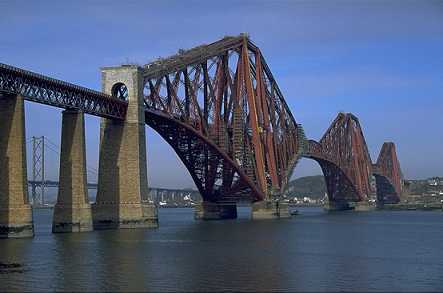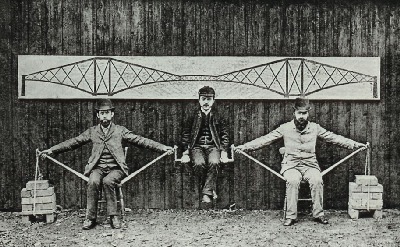The
2.5 km. (1.5 mile) Forth Railway Bridge, the world’s first major steel
bridge, with its gigantic girder spans of 521 m. (1710 ft.) ranks as
one of the great feats of civilization. It was begun in 1883 and
formally completed on 4 March 1890 when HRH Edward Prince of Wales
tapped into place a ‘golden’ rivet.
Tancred–Arrol,
constructed the bridge, robustly designed in the aftermath of the Tay
Bridge disaster by civil engineers Sir John Fowler and Benjamin Baker.
The balanced cantilever principle was adopted. The main crossing
comprises tubular struts and lattice-girder ties in three
double-cantilevers each connected by 105 m. (345 ft.) ‘suspended’
girder spans resting on the cantilever ends and secured by man-sized
pins. The outside double-cantilever shoreward ends carry weights of
about 1000 tonnes to counter-balance half the weight of the suspended
span and live load.
|
 |
| |
|
 |
This
concept is readily understood from Baker’s ‘human cantilever’ model
with his assistant Kaichi Watanabe representing the live load. The pull in his supporters arms indicates the tension in the ties and the push in the lower struts the compression in the tubes.
Each
of the 110 m. (361 ft.) high double-cantilevers is supported on
well-founded granite faced piers. The bridge’s construction involved
the employment of 4,000 men at times, the use of 54,000 tonnes of steel
and driving 6,500,000 rivets. Its total cost was £3,200,000
(~£235,000,000 today). During operations, rescue boats were stationed under each cantilever saving at least 8 lives, but still 57 men lost their lives.
The continuous painting of its 18 ha. (45 acre) surface, for the first
100 years using paint supplied by Craig & Rose, is now being done
using a state-of-the-art paint regime with at least a 20-year life.
|
In
1996 Railtrack (now Network Rail), at the request of the Health &
Safety executive, began a structural and maintenance assessment of the
structure. The result
of this was the £40m refurbishment package which began in 1998; this
comprised steelwork repairs, surface coating, access improvements and
an upgrade of the floodlighting. The contractor undertaking this work
left site in 2002 due to financial problems. Balfour Beatty Civil
Engineering gained the maintenance contract in 2002 (£10M per annum
until March 2009). The coating system employed for the steelwork
requires blast cleaning to bare metal; an application of zinc based
primer to prevent corrosion (35 microns); a glass flake epoxy
intermediate coat providing a barrier (400 microns); and, a
polyurethane gloss top coat to give an attractive “Forth Bridge Red”
finish (35 microns) on all of its estimated 400,000m². This system
which has been tried and tested in an offshore environment is designed
to give a 20year life which means the bridge may be free of its
legendary painters after 2009 for a short while!
Today, the bridge, Scotland’s biggest ‘listed’ building, continues to
form a vital artery in Network Rail's East Coast railway system; it
carries 180 - 200 train movements per day.
Try the Forth Bridges Quiz
|


